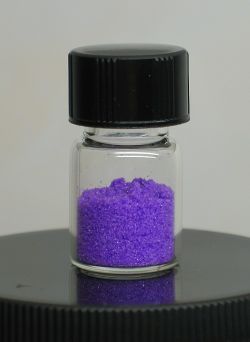Tris(ethylenediamine)nickel perchlorate
 |
This article is a stub. Please help Sciencemadness Wiki by expanding it, adding pictures, and improving existing text.
|
 The nickel complex in solid form.
| |
| Properties | |
|---|---|
| C6H24O8N6Cl2Ni [Ni(en)3](ClO4)2 | |
| Molar mass | 437.89 g/mol |
| Appearance | Violet solid |
| Melting point | Decomposes |
| Boiling point | Detonates |
| Poorly soluble | |
| Solubility | Reacts with strong acids |
| Hazards | |
| Safety data sheet | None |
| Related compounds | |
| Related compounds
|
Bis(ethylenediamine)copper(II) perchlorate |
| Except where otherwise noted, data are given for materials in their standard state (at 25 °C [77 °F], 100 kPa). | |
| Infobox references | |
Tris(ethylenediamine)nickel perchlorate is a coordination complex with ethylenediamine to nickel ions. It is easy to prepare and is highly energetic, deflagrating easily in a flame.
Contents
[hide]Properties
Chemical
Tris(ethylenediamine)nickel perchlorate is highly explosive, though its oxygen balance is not optimal, with excess ethylenediamine in the structure. Although it is energetic, it can be stored indefinitely. It is poorly soluble in water, and this can be used to aid in its production.
It dissolves in acetone and methyl ethyl ketone, and will slowly react with the ketones to form a macrocyclic compound.[1][2][3]
Physical
Unlike its nickel(II) perchlorate precursor, tris(ethylenediamine)nickel perchlorate has a strongly purple hue.
Explosive
Tris(ethylenediamine)nickel perchlorate will explode in contact with an open flame.
Preparation
Tris(ethylenediamine)nickel perchlorate can be prepared by dissolving nickel(II) oxide, hydroxide, or carbonate in perchloric acid and then adding ethylenediamine until the solution turns purple. After a day it will precipitate and the crystals can be collected.
Handling
Safety
Keep away from open flames.
Storage
It can be stored in closed containers.
Disposal
It can be safely neutralized by detonating it.
Residual perchlorates can be destroyed by adding metallic iron under UV light, in the absence of air.[4]
See also
References
- Jump up ↑ D. A. House and N. F. Curtis, Chem. Ind. (London), 42, 1708 (1961)
- Jump up ↑ http://pubs.acs.org/doi/pdf/10.1021/ja00999a008
- Jump up ↑ Coordination Chemistry of Macrocyclic Compounds, Gordon Melson, p. 39
- Jump up ↑ Perchlorate in the Environment (2000), Edward Todd Urbansky, pag. 106
http://woelen.homescience.net/science/chem/exps/Ni_en_complexes/index.html